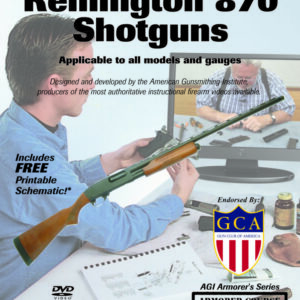Description
Bob Dunlap completely understands the design, function, and repair of this John M. Browning classic, the first lever action repeating guns he designed for Winchester, only one year after their association began with the famous 1885 Single Shot. More importantly, you will also, after he finishes teaching you its mysteries. A cut-a way gun and AGIs extreme close-up video, is used so that you can see how all of the systems work and the parts interact. If you want the quick course on how to get these Cowboy Classics apart, clean, back together, and operating as intended, then this course is for you. If you want the long course, look into our basic 108 hour Professional Gunsmith Course.
Among the items covered are:
History
- Discussion of the basic similarity of all of these Browning designs, including the later model 71 in .348 Winchester
- Discussion of the improvements in this design over the earlier B. Tyler Henry designed Henry, 1866, 1873, and 1876 Winchesters
Design & Function
- Explanation and highlighting of the twin bar bolt locking system, and its difference from that of the later model 94
- Demonstration of the feeding cycle and the cartridge stop
- Why does the cartridge rim continue to move up the lifter (carrier) after if stops lifting
- How the lever forces the lifter up
- How the firing pin retraction operation is accomplished
- What keeps the gun from firing if it is not completely locked up
- Interaction of the sear and the hammer cock notches shown, and the operation and configuration of the safety (half cock) notch
- Why the front of the hammer full cock notch cannot just be trimmed back in a trigger job
- How the gun ejects, what causes it to do so and why
- Cartridge feed from carrier to chamber and the function of the ejector in this operation
- How the extractor snaps over
- How and why the carrier detenting plungers work, do you really need to be able to have the gun feed if you are upside down and falling
- Strengths and weakness of the Browning designs in general
Disassembly
- Extensive disassembly of all parts other than the barrel, sights not removed; if necessary, they are simply driven out left to right from their dovetails
- Bob shows a remnant from the glorious magazine ban era, and how to get around it if you were anti-social
- Do not go trying to bang out that magazine band from its dovetail, take it out the right way
- Difference shown and explained between older guns with flat hammer spring and newer guns with coil hammer springs
- Why you need a screw loose to get the lever out of the gun, at least, according to Bob
- How to give the extractor more inward travel if necessary
- What can cause the cartridge to feed to the right or left if they are not of an even length
Cleaning & Lubrication
- AGI cleaning & lubrication methods shown, along with the reasons for their use
Reassembly
- Making sure, you have no parts left over
- How to do the simple function checks as you assemble the gun
Special Bonus Cowboy Tune-up
- Parts to smooth, and how to smooth them
- What tensions can be reduced, what results to expect if you do not follow the advice
- Smooth means smooth, what happens if you get too aggressive
- The commonly fouled-up trigger job, do not be an amateur. Pretend it is really a Colt. If you do not know what that means, get the trigger course. Be safe, not sorry
- What to leave alone and why
If you noticed how often the terms “explanation” and “demonstration” are used, you may be getting some idea of why this course is necessary for owners of any of John M. Brownings lever gun designs and their descendants, or someone who intends to be.




